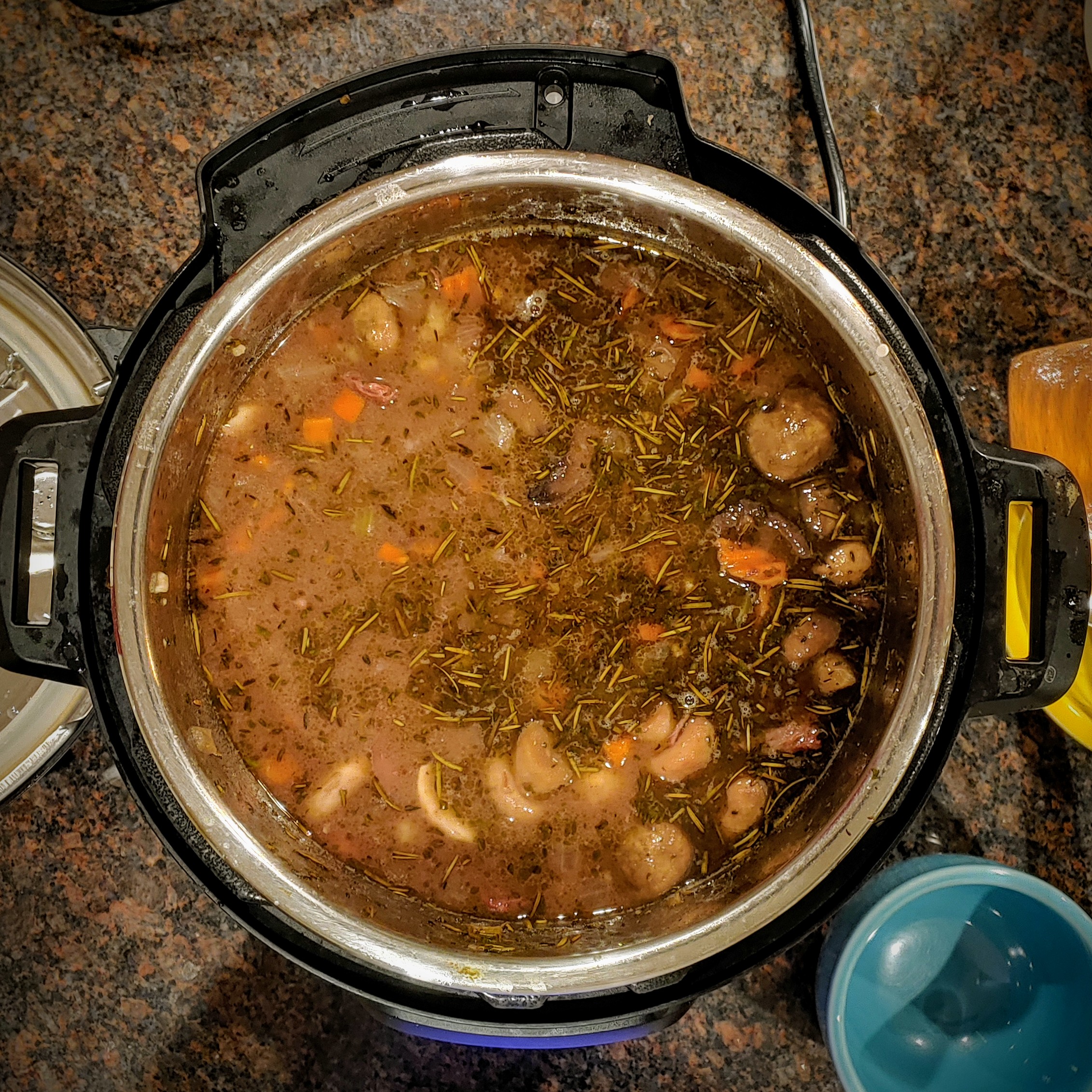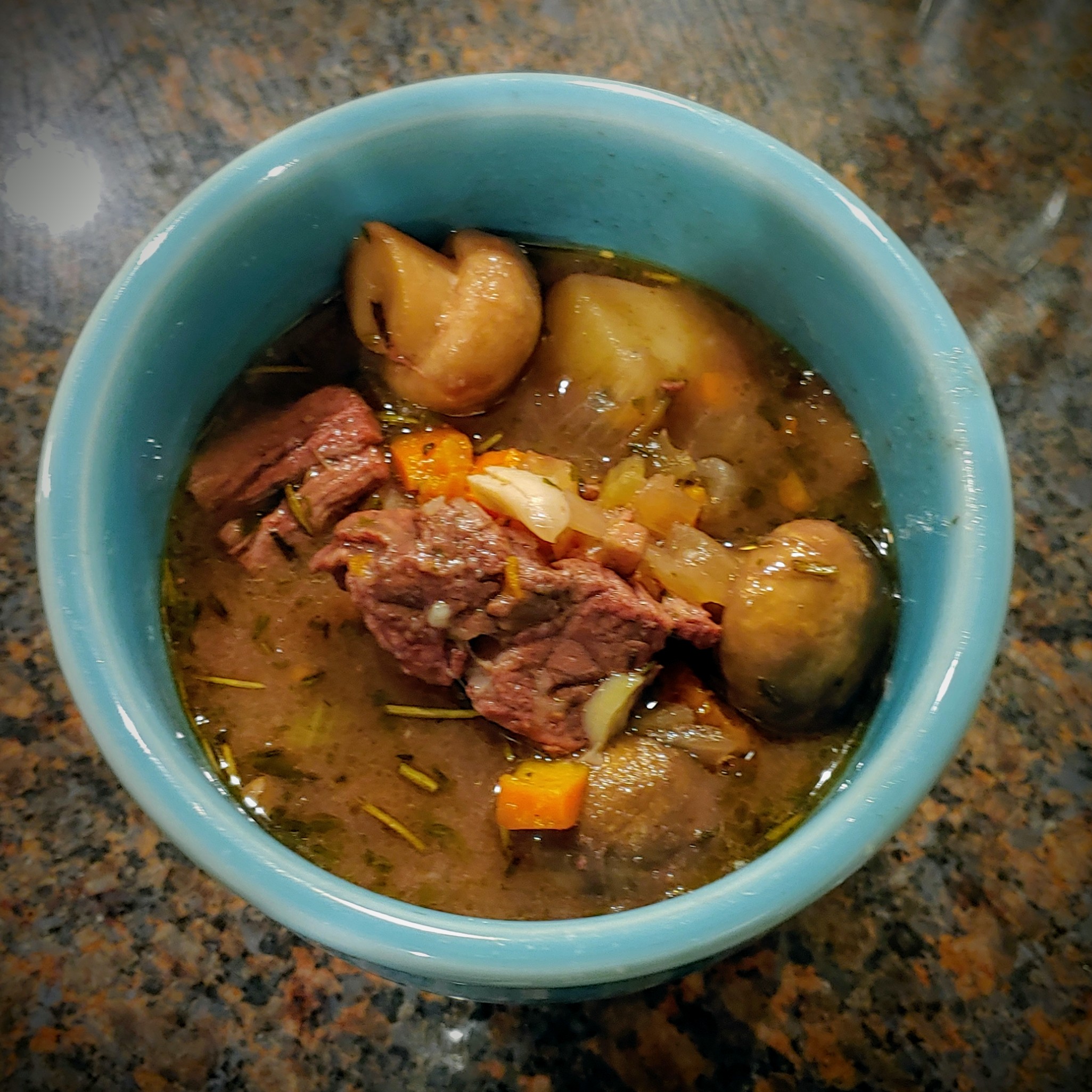...but the 2% doesn't really hurt it.
I'm proud enough about my stew today, and full on three bowls of it, that I wanted to jot down the recipe. If you hate metric measurements, it hardly matters if the proportions are about right. Even then, it's a stew, not an angel food cake; it's resilient.
Ingredients
The rendered fat from the bacon I cooked for breakfast
1 kg stew beef, cubed
500 g small yellow and red potatoes, cubed
400 g pre-chopped mirepoix from Trader Joe's
250 g whole white mushrooms, rinsed
100 g sliced mushrooms I needed to use up, rinsed
250 g sliced carrots I needed to use up
850 mL (one carton) beef bone broth
250 mL full-bodied wine
50 g (or so) pancetta cubes I needed to use up
3 small shallots, halved
1 medium garlic head, peeled (yielded about 15 cloves), larger cloves sliced in half
Herbs & spices: bay leaves, parley, sage, rosemary, thyme, plus smaller amounts of chipotle and ancho powder
50 mL of all-purpose flour
Less salt than you'd think (see below)
The ingredients exclusive of the wine cost about $20. I used a $15 bottle of wine, knowing that only one glass of it would go into the stew, but you could get good results with 3-buck-Chuck. Just make sure the wine has some heft. The Bordeaux I used was 80% merlot, 15% cabernet Franc, 5% Malbec, and it may not have had enough body.
Procedure
I poured most of the bacon fat into my Instant Pot and set it to sauté, then re-heated the bacon fat that remained on my skillet. Half of the beef went into the Pot to brown along with the pancetta, the rest went on the skillet. Once the beef was seared and had mopped up the bacon fat, it all went into the Pot and I set the Pot to slow cook, normal temperature.
Everything else except the flour now went into the Pot. It turned out I was a little low on liquid so I added about 500 mL of water—which turned out to be about 400 mL more than I needed.
Then it stewed for 7½ hours, though I did stir and taste it about once an hour.
With 30 minutes to go, I took about 100 mL of the broth out and mixed it with the flour in a measuring cup, then dumped the slurry into the Pot and stirred it up. I also cancelled the slow cook timer, then re-started it on High for 30 minutes.
Note that I put in way, way less salt than I would ever serve to other people. Salt is tricky; you need enough so that you can anticipate the finished product, but you don't want to over-salt, which is far too easy to do accidentally. So if anyone reading this gets a container to take home, keep your salt handy.


Improvements
I think I used too much rosemary, as the needles got in the way of enjoying the final stew. As I mentioned above, I also didn't need to add a full 500 mL of water; 100 mL would have done fine, or perhaps no extra water at all. The mushrooms and potatoes have so much volume to them that all the bone broth and wine didn't cover them completely, prompting me to add liquid. But I should have remembered that the alliums and mushrooms would release liquid during cooking, more than making up the deficit. Less initial liquid would have given me a thicker stew.
I also might consider sautéing the onions, shallots, and garlic before adding the seared beef. It's a tough call with slow cooking. The caramelization can add a lot to the flavor, but they'll be in the pot for 8 hours, so it might be overkill.
And I'll pick a nit about my wine choice. The Bordeaux had a lot of body and paired perfectly with the finished product. But next time, I might use a full-bodied cabernet or even a shiraz. Either that or dial the chipotle and ancho down to almost nothing.
But wow, this was one of my best efforts yet. Soo tasty, so much umami, so much depth of flavor, and so much chunky beefy and potato-y goodness, I ate three bowls of it. And now I have about 5 liters of it in Ball jars and sealed plastic containers on my counter.
I also got to drink the rest of the wine, which paired quite well with the stew.